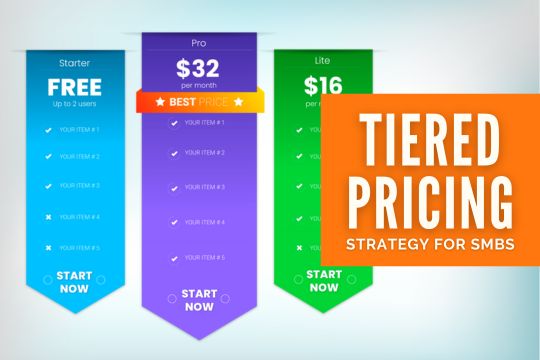
When business owners create a tiered pricing strategy for small businesses, it can be one of the most lucrative ways to increase revenue, with great value to customers. Unlike flat-rate pricing, where all customers pay the same price, a tiered pricing system groups products or services into levels, each with different features, usage limits, or advantages. Your customers get to select the level that suits them best in terms of budget and requirements, and your company gains more flexibility in assigning resources, stable revenue, and the ability to facilitate natural improvements in the future. Tiered pricing ensures cost and value correlation, fosters trust, facilitates easy decision-making, and positions your business for long-term profitability.
Tiered pricing is particularly valuable for firms with a large number of customers with different budgets and needs. Some customers will need simple access, but others will need advanced capabilities, higher usage levels, or better service levels. Dividing your offerings into distinct tiers allows you to accommodate varying needs without diluting perceived value and confusing customers. Tiered pricing also creates an easy progression for upgrades, as customers can move to a higher tier as their needs grow. Providing transparency and simple distinctions between levels reduces buying reluctance, improves customer satisfaction, and increases revenue per user.
When creating a tiered pricing strategy for small businesses, it is important to balance business objectives with customer value perceptions. Every level should give substantial differences in benefits. Higher tiers must provide more features, extended uses, or service worth the higher price, with lower tiers providing sufficient value to attract and retain price-sensitive buyers. Priced-to-perceived-value satisfies customers in their choice and promotes upgrades in the future, resulting in long-term loyalty.

Tiered pricing is more than assigning various price levels; it is about customer behavior, usage patterns, and perceived value. Several methods exist to structure a tiered system. The volume-tier model bills all units purchased by the customer at a rate corresponding to the tier in which their cumulative usage resides. This approach simplifies billing, encourages more use, and provides stable expenses. In contrast, the graduated-tier system charges different prices for units within use classes, promoting fairness and matching cost to use. Hybrid methods split the base charge between tiered usage or feature use, offering stability but the potential for customer variation with shifting demands.
Tiered pricing differs from flat-rate or usage-based systems. Flat-rate systems are simple but do not differentiate between low- and high-volume users, thus leaving revenue untapped. Usage-based pricing links cost to use, but may make costs unpredictable for the customer and business. Freemium models provide a lower level at no cost with add-ons for payment, and value-based pricing charges products or services according to perceived customer value. Tiered pricing can blend elements of each approach, achieving balance among fairness, transparency, and incremental revenue potential.
The advantages of tiered pricing are considerable. It creates an upgrade by showing customers the higher value of higher levels. It allows firms to serve various customer segments without manufacturing different products. Pricing is based on perceived value, which makes customers realize why higher levels are more expensive and increases satisfaction. Tiered pricing increases profitability, too, by capturing value from customers who can afford higher offerings while keeping entry-level offerings affordable. Finally, labeling tiers neatly simplifies the decision process, making it easy for customers to tell levels apart and choose the most appropriate.
Designing tiers is also based on pricing psychology. Pricing principles such as price anchoring, good-better-best pricing, and perceived value influence how customers make decisions. Price anchoring occurs when a higher-priced tier makes the middle option preferable, encouraging people to buy it. Good-better-best pricing leverages three levels to position the middle level as the "recommended" choice, increasing purchase likelihood. Understanding what customers want in features and benefits allows you to structure attractive levels, optimize revenue, and maintain satisfaction. Subtle wording, order, and presentation changes can have a considerable impact.

Before designing your tiers, extensive research is necessary. The key to profitable tiering is to know costs, customer segments, and perceived value. Begin by dissecting fixed and variable costs to guarantee that even the lowest tier is viable. Segment your customers by usage, preference, and willingness to pay. This analysis dictates how features, usage allowances, and benefits must be distributed among tiers. Assessing what features customers value the most guarantees that higher tiers offer valuable incremental benefits.
Benchmarking market standards is another important step. Knowing general pricing expectations positions your tiers competitively without compromising profitability. Comparing the structure and pricing of similar products or services and how customers react gives context to tailor your own better. Added to internal cost and usage data, this research provides solid ground to base effective tiers.
The number of tiers should be defined. In most situations, two to four tiers are the right balance of choice vs. simplicity. Too many alternatives overwhelm consumers, and insufficient options do not cover the range of needs or willingness to pay. Each tier must offer incremental value through more features, greater use, or better service. The prices must correspond with these differences so customers perceive upgrades as valuable.
How you present tiers affects customer purchases. Easy visual comparisons, side-by-side tables, and concise feature descriptions let customers grasp differences easily. Placement of a recommended or most bought tier subtly nudges customers toward the intended direction. Reducing feature overlap abolishes confusion, and transparency of limits, features, and pricing fosters trust. Customers must clearly identify what they pay for and receive in each tier, keeping them from getting frustrated and enhancing satisfaction.
Keep track of performance after implementation. Monitor which levels customers opt for, upgrade frequency, and usage patterns. This data informs revisions to improve clarity, purchases, and revenue. Continuous improvement ensures the tiered model remains strong and valuable. Being flexible is just as critical as your company and customers grow, as it is for your tier frameworks to remain competitive.
Advanced techniques include bundling of usage-based and feature-based levels, threshold tuning for growth stimulation, and iteration based on customer purchase patterns. Thoughtful bundling makes higher tiers desirable. Regular improvement based on analytics and user input keeps the offer competitive and profitable in the long run.
With your building blocks established, the next step is to get them working well and expanding with your business. Creating a tiered pricing system is not a one-and-done process. It's a continuous process of streamlining, tracking, and adjusting. An ideally crafted system balances customer demands against perceived value, encourages upgrades, and wrings maximum revenue in the long term. Understanding how customers interact with your tiers, along with data-driven adjustments, is the path to success over the long term.
Pricing psychology plays a decisive role in deciding tiers and customer behavior. Consumers rarely purchase solely on price. Decisions are influenced by perceived value, comparison, and presentation. A demonstration of this is the price anchoring principle that utilizes higher-priced tiers to make mid-tier options seem desirable. This underlying cognitive bias encourages consumers to select a tier that balances perceived benefits and cost. Similarly, good-better-best pricing puts a recommended level, typically the middle, as the optimal option. This tactic steers consumers to an option that maximizes and best fulfills business revenue.
Beyond tier positioning, feature communication matters. Highest tiers must provide unique, tangible value beyond merely doing more or minor features. Purchasers must understand why upgrading to a higher tier creates value in their experience. Proper feature communication with clarity, emphasizing benefits over technicality, and showing real-world repercussions raises the chance of a customer making a purchase.
Studying customer interactions with your tiers offers insights that are key to optimization. Monitor which tiers are best sellers, how frequently customers migrate, and when consumption surpasses thresholds. Monitoring patterned use can inform whether tiers are appropriately organized or if changes are necessary. For instance, if many customers stay at the introductory tier despite needing more features, the middle tier might need improved communication, more attractive benefits, or a price change.
Rolling observation allows you to refine features, modulate price increases, and set thresholds. Repeated fine-tuning ensures that every tier is desirable and affordable, in keeping with customer desires and business goals. Flexibility is critical. As products or offerings evolve and customer behavior evolves, so does your pricing model.
Successful bundling distinguishes tiered pricing. Each tier will need a distinct feature set or benefits that bring meaningful incremental value. Premium tiers will include extra features or distinctive capabilities worth the premium price. Entry-level tiers, however, need to offer a valuable and compelling starting point that satisfies fundamental customer needs with potential for subsequent upgrades.
Appropriate feature alignment is very important for tier success. Features in every tier need to align with the needs of its targeted segment. More premium tiers need to offer dramatic improvements or exclusive benefits, not just more units of existing features. Good feature bundling makes upgrades rewarding and increases premium tier purchases.
Clear tier differentiation encourages customers to perceive upgrades as a value proposition. Shallow differences or slight variations in features can degrade the perceived value of higher tiers and limit purchases. You create a natural upgrade path through the tiers by carefully pairing features with customer priorities and expectations. Customers must be able to see the value of advancing and feel comfortable assuming that every step is a series of incremental improvements.
Tier naming also contributes to differentiation. Names with value, utility, or quality implications help customers grasp differences quickly among levels. Descriptive, intuitive labels increase perceived value and reduce decision-making resistance. Poor naming will discourage or mislead customers, deterring them from selecting higher tiers. Consistency of naming conventions across offerings contributes to professional perception and drives the value proposition of each tier.

Tiered pricing optimization relies heavily upon iterative testing and adjusting. Business objectives, customer behavior, and industry trends shift, necessitating modifications to maintain viability. By studying patterns, frequency of upgrades, and customer satisfaction, businesses can identify areas to be tightened. Minor adjustments, such as editing feature bundles, modifying thresholds, or repurposing tiers, can lead to steep revenue and customer satisfaction changes.
Experimenting with different pricing structures and tier levels allows you to measure their impact on purchases. Experimentation can involve adjusting increments, changing feature splits, or emphasizing specific tiers in presentation. Insights from these experiments guide continuous refinement so that the tiered structure remains up-to-date and competitive. Iteration is a constant loop, and firms can adjust based on internal metrics and external market conditions.
While tiered pricing has numerous benefits, it is not without its weaknesses. There are frequently complex issues, such as too many tiers or cumulative features, which can force the customer to become confused or frustrated by the choices. If the features and pricing are not balanced, more expensive tiers can appear unjustified. If tiers are not adjusted as offerings or customer needs evolve, they can become irrelevant.
Emphasize clarity, transparency, and ongoing evaluation to help predict and solve these challenges. Simplify tiers to reduce overwhelm, deliver incremental value at every tier, and be transparent about features and pricing. Satisfaction metrics identify areas of concern and allow for early intervention. Adaptability also ensures tiered pricing remains competitive, customer-focused, and profitable when market circumstances vary.
Value metrics form the cornerstone of reasonable tiered pricing. Value metrics define the measurable aspects of your product or service that your buyers value, for example, usage quantities, access to specific features, or service benefits. Tiers must be constructed around these value metrics, such that each tier provides distinct, incremental value from the customer's perspective. Proper use of value metrics assists in making higher tiers worthwhile and informs customers what they receive for their investment.
It also facilitates transparency by keeping prices in line with value measures. Customers can easily compare what they receive at each level and how their investment is translated into actual benefits. Such transparency strengthens confidence, dispels suspicion, and incites upgrading. Regular scrutiny of value measures ensures tiers are in alignment with customer needs and business objectives, particularly as offerings evolve.

One of the biggest pricing strategy tips is to always reinforce the core purpose of your pricing. When we create a tiered pricing strategy for small businesses, it is important to achieve maximum profitability and customer satisfaction. With this approach, you ensure that each tier is appealing, rational, and well-differentiated. Integrating knowledge about customer behavior, pricing psychology, and value metrics creates a tiered system that grows with your business and builds long-term loyalty.
Repeating the concept repeatedly in your internal communications ensures it has more impact. Strong ongoing repetition of the strategy in internal communications, training, and documentation strengthens its relevance to decision-makers and the individuals implementing the pricing system. Frequent repetition of the need to reconcile tiers with customer value and perceived value guarantees that everyone is aligned.
An optimally executed tiered pricing structure balances revenue optimization with a rich customer experience. Knowledgeable customers aware of each tier's value will happily upgrade, propelling lifetime value. Clarity, transparency, and meaningful incremental value guarantee satisfaction, and strategic tier promotion encourages higher-value tier acquisition.
As you continue refining your pricing strategy, ensure that best practices and solutions are at your employees' fingertips. By constantly equating price to perceived value, thoughtfully building tiers, and adapting your approach through iterative application of data, your small business can apply tiered pricing to fuel sustainable growth and competitive advantage. Paying attention to presentation, differentiation, and buyer behavior ensures each tier is warranted, appealing, and affordable, creating a system beneficial to your business and customers. Working through tips on pricing strategies helps reinforce fundamentals, while subscribing to our newsletter e-marketing offers ongoing insights and news.
A tiered pricing strategy groups products or services into levels, each with its own price and benefits. Customers choose the tier that matches their budget and needs, unlike flat-rate pricing where everyone pays the same amount regardless of usage or features.
Tiered pricing lets small businesses serve varied customer budgets, capture more revenue, and encourage upgrades. It balances cost and value, builds trust through transparency, simplifies decision-making, and offers predictable income while efficiently allocating resources.
Most experts suggest two to four tiers. This range presents enough choice to cover different needs without overwhelming customers. Too many options cause confusion; too few leave revenue on the table or fail to address diverse requirements.
Base decisions on customer segments, perceived value, and costs. Entry tiers must satisfy essential needs at a sustainable margin, while higher tiers add meaningful, exclusive benefits such as advanced features, greater usage limits, or premium support that justify the price jump and motivate upgrades.
Continuously monitor sales mix, upgrade rates, and customer feedback. Use data to adjust prices, rename tiers, tweak feature bundles, or refine usage thresholds. Regular testing and iteration ensure tiers stay competitive, profitable, and aligned with evolving customer needs.